King of the Hill
- 1:08:26
- 2017
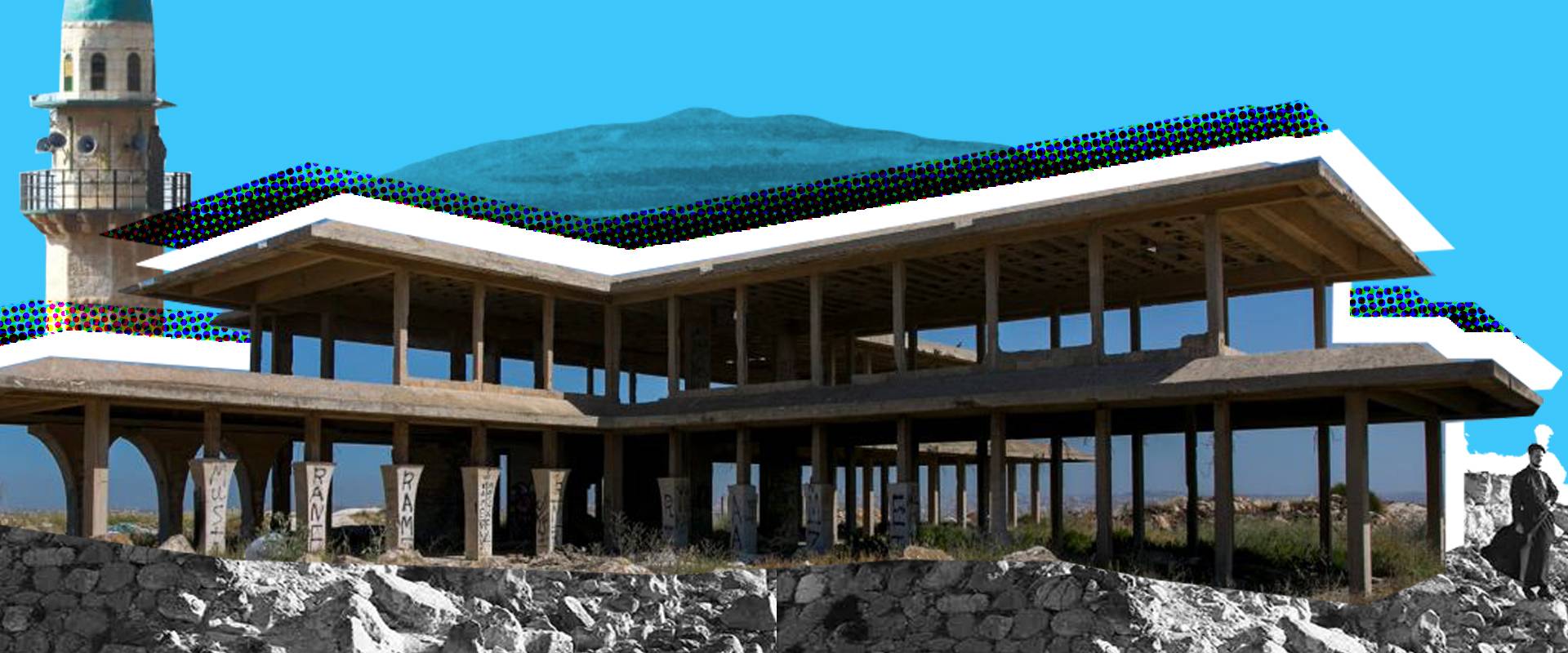
Imagine an abandoned White House, covered with graffiti, open to the winds, full of trash, broken bottles and condom wrappers. Now go a step further and picture it against the background of the most beautiful Middle Eastern panorama you can conjure up. That is Tell El-Ful, a hilltop in East Jerusalem. Ever since we learned about the existence of a deserted Hashemite palace perched atop the mound, we’ve been on a mission to uncover its past. Like many other tells in the region it has a biblical past (perhaps), an archeological past (probably) and a historical one (most definitely). But more than almost anywhere else, this litter-strewn hill is a metaphor for life in these parts: It has seen tears and blood, dreams and hopes. It has been home to kings and shepherds, soldiers and tribesmen. And it has brought together lovers and enemies; Arabs and Jews; Jordanians, Israelis and Palestinians.
Prologue
David Green, whose article got us hooked, takes us to explore the sites trippy royal past.
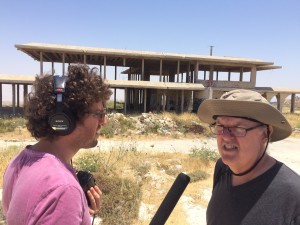
Mishy Harman (narration): Last spring I stumbled upon an article in Haaretz. It was written by David Green, and told the mysterious tale of an abandoned royal palace in the middle of Jerusalem. Now, I’ve lived in Jerusalem my whole life, I have an entire wall in my living room full of books about the city, and I go on neighborhood walking tours more or less whenever I can. But an abandoned palace? In Jerusalem? I had never even heard of it. So I called David and asked him to take me there.
[phone ringing]
David Green: Hi Mishy.
Mishy Harman: Hey David. How you doing?
David Green: Beseder, are you etzli?
Mishy Harman: Yeah, I think I am, I’m right outside your house.
David Green: OK, I’ll be down in one-and-a-half minutes.
Mishy Harman: No problem. I’m here.
David Green: OK.
Mishy Harman: Bye bye.
Mishy Harman (narration): A minute later he showed up with a safari hat and some sunscreen on his nose.
Mishy Harman: Hi David. Hey, Mishy. You look ready to do.
David Green: I am! I have my hiking boots on because it’s pretty prickly up there.
Mishy Harman: Oh yeah, you said not to come with sandals and then I completely forgot about that. Oh well.
David Green: Next time you’ll remember.
Mishy Harman (narration): Even though David had come so prepared, we kind of got lost navigating the small streets of Beit Hanina, in East Jerusalem.
David Green: Alright, I got us to the right neighborhood but, Tell El-Ful, but… okay…
[car horn]
Mishy Harman: Straight here?
David Green: Yeah, you know what, what we’ll do is, oh, shut up.
Mishy Harman (narration): After a while, and with a little help from Waze, we finally made it.
Mishy Harman: Alright, here we go!
[hand brake up, can is turned off and doors close]
Mishy Harman (narration): We got out of the car and stepped into what seemed like a concert of muezzins calling people to pray.
David Green: So we’re at the base of a hill known as Gibeah or in Arabic Tell El-Ful. And what we see right now is a field of weeds and of looks like wheat but it’s not. A very bucolic image of late spring with the terraced roof of the unbuilt, unfinished palace at the top of the hill.
Mishy Harman (narration): We started climbing up the mound.
Mishy Harman: OK, so here we are, what are we looking at?
David Green: We’re looking at the concrete frame of a kind of an Arabic-looking building. Looks like, I don’t… it looks like a very, very large villa, you know, I would say a mansion by American terms.
Mishy Harman (narration): The first thing you notice about the structure is just how odd it is. It’s somehow regal and grungy, majestic and trippy. All at once. Most of its walls were never built, but those that were are now covered with graffiti. The word ‘Gaza’ is spray-painted all over the place in both English and Arabic, as is the word ‘adel,’ which means ‘justice.’
David Green: You know, there are signs that people come here and party.
Mishy Harman: You mean like these, these bonfires and broken bottles.
David Green: Yeah.
Mishy Harman: So basically this looks like any deserted construction site.
David Green: Right.
Mishy Harman: Except that it’s of course not.
David Green: Yeah, yeah. It’s bizarre. It’s really bizarre. There are people who are dumping their garbage here. You know, building contractors who are dumping their waste and other people coming up here in the nighttime and doing I don’t know what.
Mishy Harman (narration): We began exploring the site.
Mishy Harman: Going into the basement of the building. Oh, wow. This is a serious basement here.
David Green: Yeah. Yeah. Would’ve been a nice lap pool.
Mishy Harman (narration): Walking around the palace, you can sort of squint and imagine the potential glory of this place. How the king who built it would have sat on the balcony sipping lemonade and enjoying the cool breeze. Or, if he wanted to impress his guests, maybe he’d take them up to the second floor, where David and I were now standing, to show them the view. And I have to tell you – it’s honestly one of the most breathtaking vistas I’ve ever seen.
David Green: And you have a view in ev… you know, three-hundred-and-sixty degree view in every direction. And it’s a beautiful one. You look toward the Dead Sea and the hills of Jordan on the east, you look toward the Mediterranean Sea and the coast, the Tel Aviv coast, to the west. And, ummm…
Mishy Harman: All of Jerusalem to the south of us.
David Green: Right. Right. North of us Ramallah and the northern West Bank.
Mishy Harman: You could imagine this being the most beautiful house in all of Jerusalem.
David Green: Just being here feels good. The air, the breeze is so sweet.
Mishy Harman (narration): OK, by this point, you probably have a lot of questions. Why is there an abandoned palace here? Who is that king? Where is he? And how could it be that in a city where real estate prices are skyrocketing and where every possible inch of land is fought over, there’s this huge, virtually unknown, deserted hill with such spectacular views? In our episode today, “King of the Hill,” we’ll try to answer some of those questions. And we’re gonna do so by telling a story about a place. A place that’s switched hands, and switched leaders. A place that was destined to house kings and queens, to welcome heads of state, glitterati, Hollywood A-listers and billionaires. And instead, today, is a no-man’s land that anyone can freely wander into, and mainly shelters junkies and teenagers who want to have sex. Welcome to Tell El-Ful, in East Jerusalem. I’ve been going to Tell El-Ful almost every week since that first visit with David back in May. And it’s hard, really, to capture the feeling you get there. I wish you could just come on a field trip with me and see it for yourself. But, till that happens, I guess the best way to describe it is to ask you to close your eyes, and conjure up the White House, all covered with graffiti, open on all sides, full of trash, broken bottles and condom wrappers. But Tell El-Ful is more than just a place with a fascinating past and a great panorama. It’s a symbol. Of Middle Eastern geopolitics, of competing identities, of pride, of stagnation, of a lack of leadership and – probably more than anything – of the status quo. It’s sort like an onion: You can peel off layer after layer of meaning in an attempt to start to understand this endlessly complicated region. This endlessly complicated city. Jerusalem.
Act I: The Concubine and the King
When news of the atrocities committed by the Tribe of Benjamin reached the people of Israel, a civil war broke out. Soon the Benjaminite’s stronghold, Gibeah, became synonymous with heinous crimes, lack of morality and total lawlessness. So where is Gibeah? And why does it even matter?
Act TranscriptMishy Harman: OK, so can you tell me the story of the Concubine in Gibeah?
Gil Kopatch: [Exhales]. Are there children that listen to it because it’s not a…
Mishy Harman: As you want.
Gil Kopatch: [Coughs]. OK.
Mishy Harman (narration): That’s Gil Kopatch.
Gil Kopatch: Mister Gil Kopatch [laughs]. I’m a comedian, I’m a stand-up comedian.
Yair Lapid: [In Hebrew] Please welcome Gil Kopatch.
Mishy Harman (narration): Gil became a household name in Israel back in the mid-nineties, when he was still, as he says…
Gil Kopatch: Young and wild.
Mishy Harman (narration): At the time his weekly satirical take on Parashat Ha’Shavua, the Torah portion of the week, was a Friday night hit on Channel One.
Gil Kopatch: [TV Clip in Hebrew] There wasn’t an Orangeade model at Abraham’s ball. She wasn’t there. But Rashi says… She wasn’t there. I was just kidding. [Laughter].
Mishy Harman (narration): He’d take biblical stories and turn them into comedy bits. It was funny, insightful, outrageous and always irreverent.
Mishy Harman: Is the Bible good source material for comedy?
Gil Kopatch: Ah, yes. The Bible wasn’t written to make you laugh, OK? But it also have some spots that has humor in it. When Sarah gets the announcement that she’s going to be a mother in the age of ninety-three, she said ‘G-d made laughter, tzhuck asa li Elohim,’ which means G-d himself, OK? G-d Almighty created laughter, for us. So if he created laughter we won’t use it?
Mishy Harman (narration): And that approach is what brought us to Gil’s house, in Michmoret, by the sea, to ask about the decidedly not funny tale of the Concubine in Gibeah.
Gil Kopatch: First it’s an awful, terrible story, OK? And it starts in ahhh… Where is it? “In those days, when there was no king in Israel.” Every man can do what he desires. And we are told about this guy from the Levites, the Levi Tribe, that he has a concubine.
Mishy Harman (narration): The Levite was making his way home from a visit with his concubine’s father, in Bethlehem. Here’s actress Sarah Rosen, reading from the book of Judges.
Sarah Rosen: He had with him a couple of saddled donkeys, and his concubine was with him. When they were near Jebus…
Mishy Harman (narration): Jebus, by the way, is Jerusalem which – at the time – was not inhabited by Israelites.
Sarah Rosen: The day was far spent, and the servant said to his master, ‘come on, let’s turn aside to this city of the Jebusites, and spend the night in it. But his master said to him, ‘no, we will not turn aside into a city of foreigners, who don’t belong to the people of Israel; we’ll continue on to Gibeah.’
Mishy Harman (narration): So the whole entourage, the Levite, the concubine, the servant, the donkeys, they all continued on, till – just before sunset – they reached Gibeah, a hilltop north of Jerusalem.
Gil Kopatch: Which belongs to the Tribe of Benjamin, Binyamin, not Netanyahu, Binyamin. OK? And…
Sarah Rosen: They turned aside there, to spend the night at Gibeah. The Levite went in and sat down in the open square of the city, but no one took them in to spend the night.
Mishy Harman (narration): It was probably cold. They were all tired from the long journey and just wanted to find a place to put their heads down. But in the early Iron Age, otherwise known as the days before AIRbnb, this wasn’t such a simple task. They just waited and waited. Till later that evening, an old man who lived in Gibeah came back from his work in the field.
Sarah Rosen: When the old man looked up and saw the wayfarer in the open square of the city, he said, ‘where are you going and where do you come from?’
Mishy Harman (narration): The desperate Levite answered…
Sarah Rosen: “Oh we? We’re just passing from Bethlehem in Judah to the remote parts of the hill country of Ephraim, where we come from. We’re on our way home. But nobody’s offered to take us in.”
Mishy Harman (narration): I imagine the old man looked around, trying to gauge whether this Levite was someone he wanted to invite into his home. Before he could make up his mind, the Levite chimed in.
Sarah Rosen: “We have our own straw and fodder for our donkeys, and bread and wine for me and the woman and the young man along with us. We need nothing more.”
Mishy Harman (narration): That was the clincher, and the old man said.
Sarah Rosen: “Peace be to you. I’ll take care of you, and all your needs. Just don’t spend the night in the square.” So he brought him into house, and fed the donkeys; and they all washed their feet and ate and drank.
Mishy Harman (narration): OK, so up to this point it all seems very PG. Some tired travelers are walking home, they find themselves in a foreign city where they don’t know a soul, and a kind-hearted old local invites them in to spend the night. A nice little tale of hospitality. But this is where the story takes an ugly turn, and it’s also where you might want to skip a few minutes if you’re listening with kids. Back in the old man’s house, everyone was eating, drinking, telling stories. And suddenly they began hearing loud voices from outside.
Sarah Rosen: The men of the city, a perverse lot, surrounded the house and started pounding on the door.
Gil Kopatch: These are probably youth. They were horny as hell. They were not very friendly to strangers. They were violent. They were shitholes, how do you say, assholes.
Sarah Rosen: They said to the old man, the master of the house, ‘bring out the man who came into your house, so that we may have intercourse with him.’
Mishy Harman (narration): The old man, the host, went out to these punks and said.
Sarah Rosen: “No, my brothers, don’t act so wickedly. Since this man is my guest do not do this vile thing.”
Mishy Harman (narration): But then, instead of just slamming the door in their faces, he made a surprising and frankly horrendous counter-offer.
Sarah Rosen: “Here are my virgin daughter and his concubine, let me bring them out now. Ravish them and do whatever you want to them; but against this man don’t do such a vile thing.”
Mishy Harman (narration): The crowd rejected the host’s offer. They were set on the Levite.
Gil Kopatch: And of course he doesn’t want to, you know. He said, ‘ah, I don’t want them to rape me, so I’ll, I’ll give them my concubine.’ He was a schmuck, pardon my French. So he opens the door, and takes his concubine and push her away from the house. And…
Sarah Rosen: They wantonly raped her, and abused her all through the night until the morning. And as the dawn began to break, they let her go. As morning appeared, the woman came and fell down at the door of the old man’s house where her master was.
Gil Kopatch: And in the morning he finds her dead after after they molested her all night. And he of course is very angry, you know, he couldn’t anticipate it. He was stupid!
Mishy Harman (narration): He took her body, hoisted it on the donkey and returned to his hometown.
Sarah Rosen: When he had entered his house, he took a knife, and cut his concubine into twelve pieces, limb by limb, and sent her throughout all the territory of Israel. Then he commended the men whom he sent, “thus shall you say to all the Israelites, ‘has such a thing ever happened since the day that the Israelites came up from the land of Egypt until this day? Consider it, take counsel, and speak out.”’
Mishy Harman (narration): The Levite suddenly flips. From this awful guy who basically got his concubine killed, he becomes a messenger of morality chopping up her corpse and sending it out to shock the nation. But Gil? He sees it differently.
Gil Kopatch: This is also a terrible thing to do. If you care for your concubine, bury her, pray, say the Kaddish, and maybe send letters. You send pieces of her body?! Are you crazy?! So this Levite guy, I don’t like him.
Mishy Harman (narration): Like him or not, the Levite clearly knew what pulled at the strings of these proto-Israelites. All those who received body parts, from Dan to Be’er Sheva, were outraged. They decided to get together and punish the transgressors.
Gil Kopatch: And this begins actually a civil war between all the tribes and the Benjamin tribe.
Mishy Harman (narration): In the ensuing fighting, more than seventy thousand people were killed, and Benjamin was almost annihilated.
Sarah Rosen: The Israelites put the Benjaminites to the sword – the city, the people, the animals, and all that remained. Also the remaining towns they set on fire.
Mishy Harman: So this is a really horrible story, right? And you’re a comedian. Is there anything funny that you can say about this story?
Gil Kopatch: No! [laughs].
Mishy Harman (narration): The story of the Concubine in Gibeah was, and still is, a cautionary tale. It’s taught in schools here, and has become a shorthand of sorts for a lack of leadership. It begins, you might remember, with one, evocative, phrase: “In those days, there was no king in Israel.” And look, it says, look what happened?! Rape, murder, civil war. Our collective low point. But it’s also, ironically, a tale of national rebirth. Of reconciliation. And resilience. See, following the horrors of Gibeah, more and more Israelites started demanding a king. Someone who’d unite the twelve tribes and make them into a single nation. And finally, a king was found. Saul. The son of Kish, from… you guessed it. The tribe of Benjamin. And that first king of Israel, where did he set up his capital, his palace really? In his hometown. Gibeah. The very same hilltop where the concubine had been raped and murdered. And also, of course, the very same hilltop where David and I went exploring. Tell El-Ful. Or… Is it? To answer that question we need to jump in time, from the days of the Levite and Saul, to about a hundred and eighty years ago. Starting in the nineteenth century there was an influx of western travelers to the Holy Land: Pilgrims and poets, missionaries and archeologists, surveyors and scientists. Many of them, of course, were religious Christians, who had grown up hearing the stories of the Bible. And now that they could visit the scene of action of all these famous tales…
Israel Finkelstein: They understood that there is a possibility not only to read the text at home, but to read the text in the field, and try to understand the text on the background of the geography, and the climate and geology and morphology and so on.
Mishy Harman (narration): Israel Finkelstein, an archeologist from Tel Aviv University, says that the Bible was, essentially, moving out of the realm of legendary fables that happened long ago in a faraway, almost imaginary, land, and becoming a collection of stories that happened in real places that people could now visit, and see, and excavate. One of those early researchers was an American biblical scholar from Connecticut by the name of Edward Robinson. In 1838 he came to Palestine, and together with a missionary, the Reverend Eli Smith, started connecting dozens of modern locations with places mentioned in the Bible.
Israel Finkelstein: One day Robinson went out of Jerusalem and then he came to Anata, and he understood that he is in Anatot, and then he went to Jaba and he understood that this is Geva, and then he went to Muchmas, that it’s the same Michmash, and then he understood all of a sudden that there is a preservation of the names, which means that you can read about a place named Geva, but then you go, you know, north of Jerusalem, there’s a village name Jaba, so one and one, you get a two.
Mishy Harman (narration): Among the places Robinson visited was a hill called Tell El-Ful. The name – which means the ‘Mound of Fava Beans’ or (for all the Bostonians out there) ‘The Bean Hill’ – actually didn’t correlate to anything he knew from the Bible. But nevertheless…
Shimon Gibson: Robinson was the first to identify Tell El-Ful as Old Testament Gibeah, north of Jerusalem.
Mishy Harman (narration): That’s Shimon Gibson.
Shimon Gibson: I’m a professor of practice in archeology and history at the University of North Carolina in Charlotte.
Mishy Harman (narration): The site’s location, Robinson and many others noticed, was right where the Bible said it would be.
Shimon Gibson: Tell El-Ful does command the road leading from Jerusalem towards the north.
Mishy Harman (narration): There have been four main excavations at Tell El-Ful since Robinson made that initial identification. Charles Warren in 1868, William Foxwell Albright in the early twenties, Paul Lapp in 1964 and Shimon himself, together with Tzvika Greenhut in the mid-nineties. These archeologists uncovered many ruins including what they believed were the remains of a fortress and a tower. And all this seemed to support the hypothesis that Tell El-Ful was indeed the very same place where, three thousand years earlier, the concubine had been murdered, and where King Saul had his headquarters.
Shimon Gibson: Yes, I would say that Tell El-Ful is indeed Gibeah, the place of King Saul. The wonderful thing would be if one could excavate there and find an inscription which says ‘this is Gibeah’ or an inscription mentioning King Saul. But these things are very rare. The question is whether or not this site is compatible with the biblical text on the one hand and with archeological remains on the other, and it is. It is compatible.
Mishy Harman (narration): There’s only one small problem.
Israel Finkelstein: There is no fortress of King Saul there. Albright’s fortress of King Saul at Tell El-Ful is sheer imagination. It does not exist. There are no remain that can be made into a big fortress there.
Mishy Harman (narration): The archeology, he says, simply doesn’t fit.
Israel Finkelstein: Tell El-Ful in my opinion is an easy case. Because it is not a situation that one can come and say, ‘well, you know, in the future, let’s dig fifty meters away on the slope and we’ll find there, you know, the treasures of King Saul.’ This is not going to happen. What can be found has been found, and basically we know the story of the site.
Mishy Harman: Meaning that it looks like it’s a mound of civilization, but it’s actually just a hill?
Israel Finkelstein: It’s a hill with a small ruin. That’s it!
Mishy Harman (narration): Alright, what’s going on here? How do some archeologists find a fortress and then others come along and say it’s not there? I mean isn’t this kind of a straightforward matter? Apparently, not quite. There’s this cliché about how early biblical archeologists excavated with a trowel in one hand, and a Bible in the other.
Israel Finkelstein: It’s not a cliché. I think this is basically correct I think. And I think Tell El-Ful is a good example.
Mishy Harman (narration): See, archeology – and especially archeology in this area, Israel argues – often has more to do with what you think you’re going to find than what you actually find.
Israel Finkelstein: Albright was a traditionalist, you know for him the Bible was history, and you know, in the biblical order and so on, so the whole archeology sequence of Tell El-Ful had been constructed according to the biblical verses in my opinion. When you see the way that Albright described the results of the excavations of Tell El-Ful, well… You know, you… Albright was working in the sun, here a wall, there a wall, here a piece of pottery, there a piece of pottery, you know. And then one needs to make a story from this. So he basically looked at the biblical text, and saw that there is Gibeah.
Mishy Harman (narration): For Albright that was enough. Since he believed Tell El-Ful was Gibeah, the large building he discovered there had to be, he thought, King Saul’s palace. And that, in turn, was proof that the biblical account was accurate.
Israel Finkelstein: There has always been a lot of wishful thinking, and there has always been a lot of circular argumentation in the classical biblical archeology. And once you come with modern tools and you look at it, you can pull the carpet from under the entire foundation, the whole thing goes down in no time, you know, collapses.
Mishy Harman (narration): OK where does that leave us? Was Gibeah this hill? The next one over? And why does it even matter? Well, to begin with it matters because we all want to know our past. To understand our connection to the land, especially if it’s a contentious place like a hilltop in East Jerusalem. But then there’s another layer here too. See, for many people, biblical stories need to be true. As if their power and the validity of their message are somehow diminished if they aren’t. So what about our poor concubine? Was she just the figment of someone’s imagination? Were the Benjaminites really that vicious? And King Saul? Did he end the chaos and unite the nation? On this at least Shimon and Israel basically agree.
Israel Finkelstein: It is quite easy to see that it is a polemic story. It is a relatively late story. It was put in writing probably after 587, after the destruction of Jerusalem.
Shimon Gibson: The story itself cannot be proven one way or another based on the archeological sort of evidence.
Mishy Harman (narration): Both men acknowledge that even though the polemic tale was written hundreds of years after it’s set, it might be based on some vague memory of a real event. But even if it isn’t, what really matters – Israel believes – is the message it tried to convey.
Israel Finkelstein: If you are asking me, my dear Mishy, naive reading of a biblical story doesn’t give enough respect to the text. Because the authors of these texts were sophisticated, were extremely sophisticated. They knew what they were doing. They were selling their ideology. So they are not naive. We are naive.
Mishy Harman (narration): In the case of the Levite’s concubine, and really the entire book of Judges, there’s a clear bottom line.
Israel Finkelstein: Ba’yamim ha’hem ein melech be’Yisrael. In those days there was no king in Israel. And it prepares the background for the appearance of the Davidic dynasty, first Saul of course, but mainly the Davidic dynasty.
Mishy Harman (narration): So the whole story at Gibeah, at least according to Israel, was just a way to emphasize the need for a king, and to justify the existence of a royal dynasty in the region. But, as we’ll see in the next act, it wasn’t Saul, or David or Solomon who ended up leaving their mark on Tell El-Ful. It would be another king, the second king of the hill, who – in his presence and mainly in his absence – dominates Tell El-Ful till this day.
Act II: Villa Hussein
What would it be like to have a king as your tenant? Just ask Mohammad Qutob from Beit Hanina. In a time when the ‘ownership’ of Jerusalem is back in the news, we met up with members of the city’s real aristocracy, families who have called it home for more than eight hundred years.
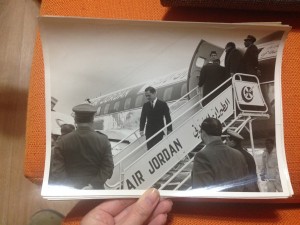
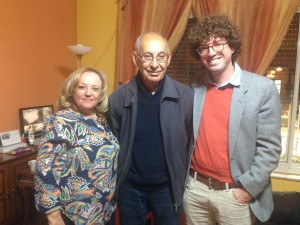
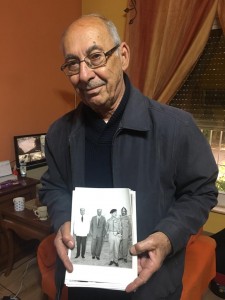
Mishy Harman (narration): Mohammad Qutob isn’t royalty, but he certainly seems like he could be.
Mohammad Qutob: I was born here in Jerusalem in 1943, and my parents and my grand grand parents are also from Jerusalem.
Mishy Harman (narration): In fact, if he wanted to, Mohammad could have continued that list on and on. See, his family, the Qutobs, have been in Jerusalem since the 12th century. That’s the 12th century. More than eight hundred years ago.
Fawz Qutob: Habibti, please have a seat.
Mohammad Qutob: Sit down here.
Mishy Harman: Thank you so much.
Mishy Harman (narration): We met with Mohammad and his wife Fawz in their spacious home in Beit Hanina, at the foot of Tell El-Ful, just a few hundred meters down the hill from the abandoned palace where David had taken me.
Mishy Harman: And is this house still today called ‘Villa Hussein’?
Mohammad Qutob: Walla, that’s what got stuck in our address. We call it Villa Hussein, Beit Hanina, East Jerusalem. That’s our address.
Mishy Harman (narration): We’ll get back to why the Qutob house is called Villa Hussein, but for now all you need know is that Beit Hanina is a Palestinian neighborhood in East Jerusalem. Today it has more than 35,000 residents, and everywhere you look you see cranes and construction sites and new apartment buildings. But when Mohammad was a kid, Beit Hanina was just another small village on the road from Jerusalem to Ramallah.
Mohammad Qutob: In the ‘50s it was vineyards and olive trees and figs, and the people were living off the land, you know.
Mishy Harman (narration): In a way, not all that much had changed in that area since the days in which King Saul either did or did not rule from the top of the hill. I mean empires came and went and rulers changed, but daily life itself was surprisingly stable. Generation after generation of farmers grew their crops, cared for their animals, and worshiped their gods. There were, however, a few outstanding events: In the first century CE, en route to conquer Jerusalem and vanquish the Temple, the Roman army’s tenth legion camped on Tell El-Ful. And more than eighteen centuries later, in the very same spot, the British fought a big battle against a coalition of Germans and Turks during World War I. Then came 1948. To some, the glorious War of Independence, to others, the catastrophic Nakba. At the end of the fighting and after the signing of the Armistice Agreements, East Jerusalem – which included Beit Hanina and Tell El-Full – ended up on the Jordanian side of the border.
TV Reel: Arriving in New York on the Queen Mary is Dr. Ralph Bunche, Acting United Nations Mediator in Palestine. He reports on the successfully concluded Armistices that have ended armed conflict between Israel and the Arab states.
Mohamad Alami: You have to go back to 1948, it was a tremendous shock to the Palestinians, you see.
Mishy Harman (narration): That’s Mohamad Alami.
Mohamad Alami: I’m from Jerusalem, and quite proud of it, you know.
Mishy Harman (narration): Like Mohammad Qutob, Mohamad Alami comes from one of the most celebrated Palestinian families in town.
Mishy Harman: How many generations have you been in Jerusalem?
Mohamad Alami: Oh, well over thirty. Yeah.
Mishy Harman: So, you’re a real Jerusalemite?
Mohamad Alami: I am. It’s nice to have so many centuries behind you. It doesn’t matter who rule in Jerusalem as long as I stay here.
Mishy Harman (narration): The Alamis outlasted the Mamluks, the Ottomans, the British.
Mishy Harman: And, in 1948, you became suddenly a Jordanian.
Mohamad Alami: Yes, well, I never had a choice in my life to decide what. So I just float. [laughs].
Mishy Harman (narration): Not all the local Palestinians were as sanguine about this turn of events. There was, Mohamad Alami admits, a lot of…
Mohamad Alami: Mistrust, fear.
Mishy Harman (narration): You see, Jordan was ruled by the Hashemite family, who were descendants of the Sharifs of Mecca. They were outsiders from the Arabian Peninsula, elevated to the throne with the support of Lawrence of Arabia and the British. In short, they were most definitely not Palestinian. And that meant that they lacked legitimacy, both in Jordan itself and – perhaps even more so – among the Palestinians of the West Bank and Jerusalem who…
Mohamad Alami: Held the view that the Jordanian Royal Family collaborated with the Israelis in some cases and so on. It’s just rumors, you see, but certainly there was mistrust.
Mishy Harman (narration): Eran Tzidkiyahu is a research fellow at the Forum for Regional Thinking. He specializes in Jerusalem geopolitics, and he explained to me that the city was a center of Palestinian nationalism.
Eran Tzidkiyahu: Rising and evolving Palestinian nationalism.
Mishy Harman (narration): Those national aspirations had, of course, been dealt a severe blow in 1948. And now, once again, the Palestinians found themselves under foreign – albeit Arab – rule. Some even called it…
Eran Tzidkiyahu: The Jordanian occupation of Jerusalem.
Mishy Harman (narration): Most of the time this tension remained underneath the surface. But occasionally, things got out of hand.
Eran Tzidkiyahu : Up to the point were there were violent clashes between protesters and the Jordanian security forces.
TV Reel: To the Old City of Jerusalem, King Abdullah went for a Friday prayers. Among his own people he walked, unguarded and unafraid.
Eran Tzidkiyahu: Well, maybe the most manifest example, Palestinian nationalists assassinated the Jordanian king.
TV Reel: But there were those who hated him. And as the king entered the mosque to pray, a young fanatic killed the one man who might have brought peace to the Middle East.
Mohamad Alami: Well I must have been about six years old, you know, thereabouts. I was visiting my grandfather, and we usually had the radio on for the Friday prayers, and then suddenly we heard shots.
Mishy Harman (narration): King Abdullah of Jordan was assassinated in 1951, at the Al-Aqsa Mosque. His violent end shocked the entire region. But it left a lasting mark on the man who was standing right next to him when he was shot – his fifteen-year-old grandson Hussein. According to some of his biographers, Hussein was actually saved when one of the assassin’s bullets deflected off a medal his grandfather had insisted he wear. In any event, everything about that day remained etched in his mind. Including the setting. He would, he promised himself, become the protector of Jerusalem’s Haram esh-Sharif, and its holy mosques. Less than thirteen months later, the teenager was crowned king. King Hussein of Jordan. From the get-go, establishing his control over Jerusalem was a priority for the young monarch.
Eran Tzidkiyahu: Hussein tried to undermine Palestinian nationalism, and to convince Palestinians that they can live happily under his control.
Abdullah Sawalha: King Hussein he want to make Jerusalem as a second capital to Jordan. Or at least a spiritual capital.
Mishy Harman (narration): That’s Dr. Abdullah Sawalha.
Abdullah Sawalha: I’m the founder and director of Center of Israeli Studies in Amman.
Mishy Harman (narration): Now one good way for King Hussein to have more of a presence in Jerusalem – Abdullah explained to me over Skype – was to have more of a presence in Jerusalem. And that brings us back to Mohammad Qutob and his villa, Villa Hussein. In the late fifties, Mohammad’s father, Abdel Muti Qutob, bought a large plot of land in Beit Hanina.
Mohammad Qutob: It was fashionable for people to move from the Old City, and to come and buy land here in Beit Hanina and Shuafat and to build villas.
Mishy Harman (narration): But the Qutobs’ new house was no ordinary villa. It was designed by a famous Egyptian architect, Said Kareem. It had four floors, a semi-circular private driveway, a water fountain at the entrance and a huge garden in the back. Really fancy, especially for those days. In 1960, the construction on the villa was done, and the Qutob family moved in.
Mohammad Qutob: We lived here for a couple of months, and one day I was hunting in Salfit, you know with my cousin and uncle.
Mishy Harman (narration): At the end of the hunt, they headed back to the villa in Beit Hanina.
Mohammad Qutob: And we came past this house, we saw a lot of military cars and so on. So we couldn’t stop because I had those shotguns and so on. I didn’t know what was going on, ah? So we continued to my uncle’s house in Sheikh Jarrah, and then after a while I came back, I said ‘what was going on here in the house?’ They told me King Hussein was here…
Mishy Harman (narration): That’s right. Apparently King Hussein himself had stopped by for a visit. And why? Well, he had seen the Qutob’s gorgeous new home, fell in love with it, and wanted to rent it and make it into his own Jerusalem residence. Hussein was only twenty-five at the time. He had already been married, and divorced, and acquired somewhat of a reputation as a jet-setting playboy. He loved racing cars, flying airplanes, and – by all accounts – beautiful women. Now, when a king wants to become your tenant, I guess you can’t really say no.
Mohammad Qutob: Well of course, I mean it’s an honor to have this relationship with King Hussein.
Mishy Harman (narration): So without too much hesitation, Abdel Muti Qutob…
Mohammad Qutob: Offered it to him with pleasure.
Mishy Harman (narration): They soon signed a lease.
Mohammad Qutob: It was rented for 3,500 Jordan Dinars per annum.
Mishy Harman: Was that a lot of money?
Mohammad Qutob: Oh, it was quite a lot of money at the time, ah.
Mishy Harman (narration): The Qutobs, who had basically just moved in, repacked their bags and moved out. And their lavish new villa? It was now… a palace. An actual palace.
Mohammad Qutob: Yes it was called King Hussein’s Royal Palace. And there was a crown and a sign here at the, on the street saying don’t blow your horn, you know, because this is a royal palace. Ya’ani these are things from the past, you know? Good memories.
Mishy Harman: Do you live now in the room that King Hussein used to live in?
Mohammad Qutob: The bedroom? No, it’s vacant. It’s on the third floor. Would you like to see?
Mishy Harman (narration): Mohammad and his wife Fawz gave us a tour of the house. They showed us what was once Hussein’s private kitchen, the official dining hall and the surprisingly simple royal master bedroom.
Fawz Qutob: This is King Hussein’s bedroom. This one.
Mishy Harman (narration): Fawz opened the door leading out onto the balcony.
Mishy Harman: Wow, beautiful balcony.
Fawz Qutob: Yeah.
Mishy Harman (narration): For five years King Hussein enjoyed long serene evenings on that balcony, looking out towards Nebi Samuel, and – in true Davidic style – chatting with women hanging up their laundry on the nearby roofs. During that time he got remarried to a British twenty-year-old, Antoinette Gardiner, whom he met – fittingly – on the set of Lawrence of Arabia. Their first son, Jordan’s current king, was named for Hussein’s beloved slain grandfather, Abdullah. But life wasn’t all fun and games, even for a jovial guy like Hussein. In 1964, the PLO, the Palestinian Liberation Organization, was established, and Hussein was afraid he would become the target of a popular national revolt.
Mohammad Qutob: Walla he was blamed by a lot of people that he was investing more in Amman than he is investing here in Jerusalem. But King Hussein wanted to establish himself here. To show the people that he is also concerned about the West Bank.
Mishy Harman (narration): So Hussein decided he’d build himself an official palace in Jerusalem. No longer some rented out villa, but rather a magnificent stronghold that would bolster his standing in the region and signal how close Jerusalem was to his heart. And since he had spent all those years in the Qutob’s house, it made sense to select a place nearby. A place with an even better view, right at the top of the hill. The palace Hussein envisioned would be a masterpiece. The most beautiful house in all of Jerusalem. This is where the royal family would come when they wanted to escape the sweltering Amman summers, and this is where Hussein would invite guests from around the world, to show them the panoramic view of the Holy Land from the Mountains of Moab all the way to the Mediterranean Sea. We’ve spent the last few months trying to understand how exactly King Hussein acquired the land at the top of Tell El-Ful. We’ve gone through property deeds, been in touch with historians, archivists, officers at the land registry. And the bottom line is, we’re not sure. It’s possible, as many people say (especially in Jordan) that he purchased the plot from its legal Palestinian owners. It’s also possible that he just annexed it. At least one reliable source told us, confidentially, that Hussein did in fact confiscate the land, but that he intended to pay the owners handsome reparations. We couldn’t verify whether any money actually exchanged hands, and if so, whether it was Hussein’s private money, or else Jordanian governmental funds. And this point is important, since it determines who actually owns the land today, and what can, or can’t, be done there. In any event, in 1965 construction at the top of hill began. Over the next two years workers vigorously dug foundations. They poured the cement for a ten-car garage where King Hussein could park his fleet of race cars. They built extensive servant quarters, and – at the very summit – they erected the concrete skeleton of the palace itself, including a basement and two stories. The walls and stone facade weren’t yet ready, but almost everything else was – a staircase, columns, balconies, even space for a fireplace. It looked like finally, three millennia after Saul, the hilltop would have its king. And then… Then came the Six Day War.
[Beat]
June 6, 1967 was – Hagai Mann told me – a clear day.
Hagai Mann: Very clear day, yeah.
Mishy Harman: Was it hot?
Hagai Mann: Yeah, June.
Mishy Harman (narration): Hagai’s eighty today. He’s still strong, stoic, and speaks with the kind of precision and authority you’d expect from a retired colonel in the Israeli Army. But I came to talk to him about that hot June day.
Hagai Mann: It’s bring me back when I was a little bit younger.
Mishy Harman (narration): At the time Hagai was a thirty-year-old intelligence officer.
Hagai Mann: Of the tenth mechanized brigade, Hativat Har’el, Harel Brigade.
News Reel: (Hebrew) At 7:30am the Israeli Air Force attacks Egypt’s airfields. Within three hours… [goes under].
News Reel: For the third time since its birth as an independent state, Israel is embroiled in a war with the Arab nations that surround it.
Mishy Harman (narration): The Six Day War began on June 5, 1967, when the Israeli Air Force attacked and destroyed Egypt’s airfields. The success of that preemptive strike basically determined the outcome of the war, and Israel immediately sent a pacifying message to the Jordanian king, Hussein, saying that it had no intention of fighting him in the West Bank, or in Jerusalem. Here’s Abdullah Sawalha again.
Abdullah Sawalha: Our prime minister at that time, Wasfi al-Tal, he cried in front of King Hussein to not engage in this war because he was very sure that we would lose this war.
Mishy Harman (narration): But the thirty-one-year-old Hussein didn’t listen. And within a few hours, he decided to attack.
News Reel: [Hebrew] That same morning at 10:30am, Hussein began his own move, and started bombarding all parts of Jerusalem.
Hagai Mann: He start shooting and we have no choice but to open another front, against Jordan.
Mishy Harman (narration): When Hagai looks back at those dramatic days, he can imagine an alternative course of events. One in which Hussein would have stayed out of the war, and, well, the last half century – the intifadas, the wars, the violence – would have taken on a different shape.
Hagai Mann: I think that if he will not participate to this war, Jordan could keep the West Bank, all the West Bank, Jerusalem in his hand, and he could be a big winner.
Mishy Harman (narration): Whether or not that counterfactual history is convincing, here’s what actually happened. Just as soon as Hussein started bombarding Jerusalem, Hagai and his friends from the Harel Brigade were mobilized.
News Reel: (Hebrew) At 10:30am the Harel Brigade were ordered to start moving to Jerusalem.
Mishy Harman (narration): One of their first objectives? Conquering Tell El-Ful.
Hagai Mann: Tell El-Ful is the dominant terrain in the area. A very high hill, controlling very important roads. The way to Jericho, and the main way from Jerusalem to Ramallah.
Mishy Harman (narration): And, of course, in addition to the strategic importance, there was an added symbolic incentive.
Hagai Mann: We knew that King Hussein is building his palace there.
Mishy Harman (narration): Hagai also knew that Tell El-Ful was a well guarded position.
Hagai Mann: And we find out, on the sixth of June, very early in the morning, that it was fortified by tanks. A platoon, or more than a platoon, a company of tanks.
Mishy Harman (narration): Soon after dawn broke the Harel Brigade commander, Uri Ben-Ari…
Hagai Mann: Gave an order how to conquer, or how to take Tell El-Ful.
Mishy Harman (narration): And at 8am they charged.
Hagai Mann: It tooks about half an hour that we conquered this hill. It was not very heavy shooting and so forth, and the Jordanian run away to the east. For them it was, I believe, a big surprise. At about eight-thirty, nine o’clock in the morning, we were already on this hill, cleaning from Jordanian soldiers.
Mishy Harman: Were people killed on Tell El-Ful?
Hagai Mann: I think that three or four soldiers were killed on Tell El-Ful itself.
Mishy Harman: Israeli soldiers?
Hagai Mann: Israeli soldiers, of course. But…
Mishy Harman: And Jordanians?
Hagai Mann: And Jordanian were, I don’t remember exactly but about ten-fifteen soldiers, Jordanian, or more, were killed on this hill.
Mishy Harman: Was there also any resistance by the local population?
Hagai Mann: There was no population, no civilians were there. Nothing was populated on Tell El-Ful. It was empty. Beit Hanina was populated with people but they were all in their villas or their buildings and no one was on the street. They were very frightened, I believe.
Mishy Harman: So you didn’t even see them?
Hagai Mann: No, we didn’t see them. Nobody was on the street. Nobody. We didn’t see any Arab people there.
Mishy Harman (narration): I asked Hagai if, as they were charging up the hill, he thought about the locals, people like the Qutob family, Palestinian Jordanians who were about to become Palestinian Israelis. Or, for that matter, if he had any chance to think at all. About the danger or about Jerusalem’s Old City, which was just a few miles away.
Hagai Mann: During the fight itself, you have not the time to think, it is danger or not. You are moving and with the force, and succeeding. And the feeling when you are on the top of the hill and it’s clean and clear from enemy, this is a good feeling of course. Jerusalem was like on your hands, lying on your hands, and it was very very impressive. Yeah. We did it. And from there we moved to Ramallah, we took Ramallah. And later on, on the following day, we took Jericho.
Mishy Harman (narration): Even though Tell El-Ful is just off the highway Hagai uses almost every day on his way to work, he’s only been back a handful of times since 1967. But about ten years ago, Hagai – who is the Minister of Immigration’s Chief of Staff – was asked to take a visiting Jordanian dignitary on a tour of the area. The Jordanian in question was the Head of Military Intelligence. But back in ‘67, they quickly figured out…
Hagai Mann: He was the company commander of the tanks that were fighting against us in Tell El-Ful.
Mishy Harman (narration): The two former enemies went back to the hilltop where they had battled against each other. Everything around them was practically unrecognizable – new neighborhoods, tens of thousands of new houses, new roads, highways. But amazingly, the hill itself hadn’t changed a bit. You see Tell El-Ful is basically a time capsule. It’s exactly as it was on June 6, 1967, when the two men had last been there. They walked around the ruins of the palace.
Hagai Mann: And I told him, ‘this is the place where the tank was hit by us.’ He said, ‘walla, this is the place!’ I said ‘I know, I saw the tank there.’
Mishy Harman (narration): What was it like, I wondered, standing there with his old foe, reminiscing about their exact locations when they had tried to kill each other.
Hagai Mann: Look, during the years you have different feelings. When we were young it was another feeling and nowadays, of course, you said, ‘OK, you make peace with your enemy.’ So, we shake hands, and that’s it.
Act III: The Frozen Palace
The lavish halls that were supposed to house heads of state and billionaires are now full of thorny bushes and heaps of garbage. What would have been the wine cellar is now prime location for daring make-out sessions. Welcome to King Hussein’s royal palace, exactly fifty years after the outbreak of war abruptly halted its construction.
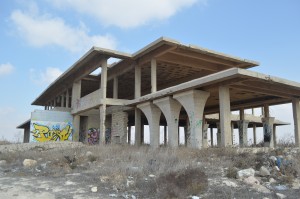

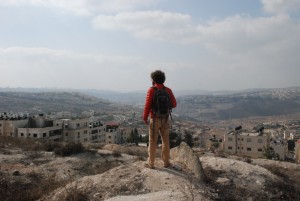
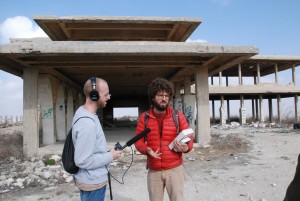
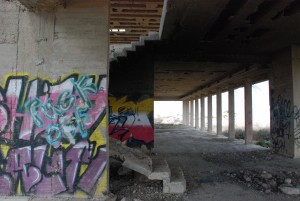
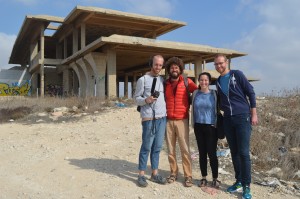
Mishy Harman (narration): As we were walking back to our car, at the end of my very first visit to Tell El-Ful last spring, David Green and I were trying to make sense of this odd architectural skeleton we had just seen. In a way it’s like seeing a ghost. A ghost of a different time, and – as strange as it is to say this about a physical location – a ghost of a different place.
David Green: It’s amazing to me that this palace… that construction stopped on this palace more than fifty years ago, and it’s… it’s the only thing in Jerusalem that hasn’t changed since then. It’s just… it’s almost completely intact. And Israel never touched it.
Mishy Harman: It’s like a fossil of 1967.
David Green: Right.
Mishy Harman (narration): Almost nothing has happened on the top of Tell El-Ful since Hagai and his friends conquered it, half a century ago. And why is that? G-d knows that Jerusalem is growing at a dizzying pace. Every possible vacant lot has been turned into a new apartment building, every last green valley or terraced hill has become a new neighborhood or shopping center. But Tell El-Ful is different. Ironically, its ambiguous ownership and unclear legal status are what spared it from the fangs of real estate developers and municipal city planners. It’s just too sensitive and no one, neither the Israelis nor the Jordanians, want to touch it.
Hussam Wattad: It would spark a diplomatic crisis at the highest levels.
Mishy Harman (narration): It would spark a diplomatic crisis at the very highest levels, Hussam Wattad told me. Hussam is the director of the Minhal Ha’Kehilati in Beit Hanina, which is sort of like being the mayor of the neighborhood. And he’s right. Any movement at all on this hill – any construction, any excavation, any attempt to clean it up even – would be seen as an assault on Jerusalem’s delicate, often unspoken, status quo.
Eran Tzidkiyahu: If something will take place, for example a Palestinian group from Beit Hanina will try to establish this Hashemite structure as a community center, then it will seem to the Israeli authorities as kind of a creeping takeover.
Mishy Harman (narration): That’s Eran Tzidkiyahu, the Jerusalem geopolitics expert, again.
Eran Tzidkiyahu: If a group of settlers will enter the structure suddenly then of course it will turn on all the alarm bells in Amman saying oh you can’t use this Hashemite structure for a settlement, right?
Mishy Harman (narration): And so the half-built palace still stands. A monument to stagnation. A symbol of unfulfilled dreams. Of wasted potential. The Hashemites, David said…
David Green: Couldn’t move it, they couldn’t finish it, and Israel didn’t touch it, didn’t demolish it, didn’t finish it, didn’t take it over and make another use of it. And it stood here, the shell of this building, for the last fifty years. (It’s now exactly fifty years since the war).
Mishy Harman (narration): In a way, it’s easier for all sides involved just to forget about Tell El-Ful. To pretend it doesn’t exist.
Eran Tzidkiyahu: Despite the fact that you can see it from many places and it’s high and overlooking its surroundings, it’s almost transparent. It’s a liminal place, it’s in between the neighborhoods and its in between the Jews and the Arabs, it’s in between the desert and the settled land, its a place that is kind of stuck in the middle.
Mishy Harman (narration): So what does a forgotten place look like? Who steps in when there is no king around? Well, you’ve heard the concubine story, so I’m sure you can guess.
Hussam Wattad: [In Hebrew] The place is neglected, no one takes care of it. It’s mainly used by criminals, drug dealers, addicts, prostitutes, whatever you can imagine.
Mishy Harman (narration): “The place is neglected,” Hussam says, “no one takes care of it. It’s mainly used by criminals, violent people, drug dealers, addicts, prostitutes, people of the night.” There are piles of trash everywhere. Shredded tires, plastic bottles, dirty diapers. It’s kind of disgusting. But there’s also something mesmerizing about this filth. About the gap between the grime, the stunning views, and the decaying grey regal structure. The parents of Beit Hanina, of course, don’t see all this poetic beauty. Instead, they just warn their kids not to go there. Take Niveen Dajani, for instance.
Niveen Dajani: I always hear that it’s very dangerous place. People maybe taking drugs there, smoking, I’m afraid.
Mishy Harman (narration): Niveen, her husband Ashraf Nashashibi, and their two kids, Talaa and Tareq, live right beneath the palace, a five minute walk down the hill. But Tareq, who’s almost thirteen and is very obedient, has only been there once in his whole life.
Tareq Nashashibi: Well once it was snowing here and my sister and I chose like to get a sleigh and to slide down on the snow, it’s going to be really, really nice. But we went up, up, up, up and we found like this place it was really, really dark and you couldn’t see anything and there were like electrical webs all around it so we thought it’s a good idea to go back instead of being in trouble.
Niveen Dajani: I can tell Tareq don’t go there, if he wants, he will do it but I think always he listens to us.
Tareq Nashashibi: Yeah. It’s actually really, really scary also like alcohol people, drunk people will be there and yeah, so it’s not really safe up there so I don’t suggest to go.
Mishy Harman: And tell me, in your imagination, in your dreams what do you think one could do with the palace?
Tareq Nashashibi: Well, if right now I close my eyes and imagine.
Mishy Harman (narration): Tareq said he’d like it become a palace again. With a real king and a queen. I asked him whether he thought it would be fun to live right next door to a palace. You know, hordes of tourists, overpriced chachkes, security barriers. But Tareq, he only sees the upside.
Tareq Nashashibi: It would be like great because the first thing I’m going to do is just to take a selfie.
Mishy Harman (narration): What I like about Tareq’s idea is that it’s just as plausible, just as worthy, just as likely, as any of the other ideas I heard while working on this story. Some people said it should become an archeological park featuring King Saul look-alikes, others suggested moving the Knesset here, or building a museum for King Hussein, or a swimming pool, or, a picnic area. You see, each one, at the end of the day, has his or her own fantasies about Tell El-Ful.
Mohammad Qutob: It is linked to King Hussein and those golden days of Jordan. When the two West Bank and the West, East Bank were united. And there was freedom of movement and so on. This is also a cause for remembering.
Hagai Mann: There is no emotion. We fought there. People were killed there. That’s it.
Eran Tzidkiyahu: The kids smoking pot and drinking alcohol behind the concrete skeleton is not less important than the kings and the rulers building palaces in this land. They’re actually the real thing.
Mishy Harman (narration): For me Tell El-Ful has become a place to come and think. Think about how history goes in one direction and not another. Think about what if. About what could. As my thoughts bounce between King Saul and King Hussein, between the Levite, the concubine, the Qutobs, the Alamis, Hagai, Tareq, it seems like the entire history of Jerusalem could be told through this hill. I mean, sure, like many other sites in this country it has its own particular past – a biblical one (maybe), an archeological one (perhaps), a historical one (definitely). But really, at least to me, Tell El-Ful is a metaphor of our lives here. This deserted, litter-strewn mound, has seen cycles of tears and blood, dreams and hopes. It’s been home to royals and to shepherds, to soldiers and to kids. It’s brought together lovers and enemies, Arabs and Jews, Jordanians, Israelis and Palestinians. And the hill itself? As we battle each other and kill each other, as we make peace and make war, the hill just continues to stand there. Oblivious. Like the Alami family, it doesn’t really care who rules Jerusalem, just as long as it can stay exactly where it is.
That’s Tell El-Ful.
Credits
The episode was produced by Yuli Shiloach, Hannah Barg, Zev Levi and Mishy Harman. It was edited by Julie Subrin, recorded by Ben Wallick, and mixed mixed by Sela Waisblum. The original music in this episode was composed and performed by Ari Jacob, with help from Yochai Maital. The final song, “Wen Ya Galub,” is by Dudu Tassa and the Kuwaitis. Thanks to: David Green, Sarah Rosen, Maya Rosen, Dalia Belkin, Chaim Silverstein, Yoni Yahav, Mustafa Alami, Lina Qutob, Abood Qutob, Mohammad Dajani, Simone Katz, Zach Sicherman, Avi Shlaim, Michael Falero, Hélène Franchineau, Mikey Ezrachi, Naomi Schneider, Hadas Shteif, Peter Fogel, Gideon Avital, Eve Sneider, Federica Sasso, David Harman, Dorothy Harman, Esther Werdiger and Wayne Hoffman.
Sponsors
 Best-Day Adventures offer specialized trips for active Jewish singles in their 40s, 50s and 60s. They plan their trips to a tee, with top-notch services, fun icebreakers, and an indulgence of enriching discoveries designed to create a warm, welcoming environment.
Best-Day Adventures offer specialized trips for active Jewish singles in their 40s, 50s and 60s. They plan their trips to a tee, with top-notch services, fun icebreakers, and an indulgence of enriching discoveries designed to create a warm, welcoming environment.

 Wartime Diaries
Wartime Diaries

